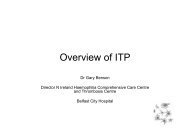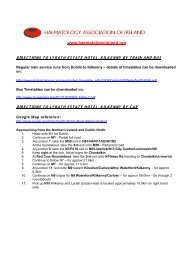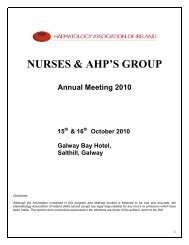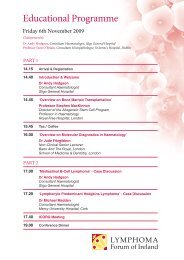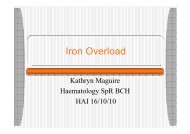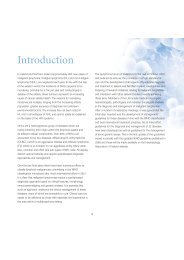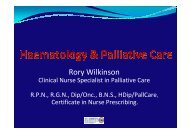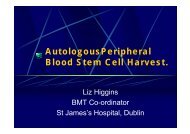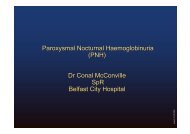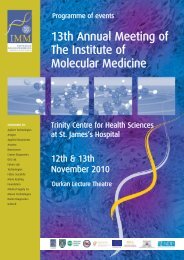Guidelines on Diagnosis and Treatment of Malignant Lymphomas
Guidelines on Diagnosis and Treatment of Malignant Lymphomas
Guidelines on Diagnosis and Treatment of Malignant Lymphomas
Create successful ePaper yourself
Turn your PDF publications into a flip-book with our unique Google optimized e-Paper software.
Enteropathy-Type<br />
T-Cell Lymphoma<br />
Definiti<strong>on</strong> <strong>and</strong> Incidence<br />
Enteropathy associated T-Cell Lymphoma or enteropathy-type<br />
T-cell lymphoma (EATCL) is a tumour <strong>of</strong> intraepithelial<br />
T-lymphocytes showing varying degrees <strong>of</strong> transformati<strong>on</strong><br />
but usually presenting as a tumour composed <strong>of</strong> large lymphoid<br />
cells. This most comm<strong>on</strong>ly occurs in the setting <strong>of</strong> pre-existing<br />
or underlying (<strong>of</strong>ten undiagnosed) coeliac disease. These<br />
recommendati<strong>on</strong>s apply to EATCL but there is little evidence to<br />
suggest that n<strong>on</strong>-EATCL should be treated differently. The median<br />
age <strong>of</strong> presentati<strong>on</strong> is 50 years with a male predominance.<br />
ICD-O Code 9717/3<br />
Clinical Presentati<strong>on</strong><br />
EATCL usually presents with abdominal pain, weight loss,<br />
diarrhoea <strong>and</strong> vomiting but may present acutely with small<br />
bowel obstructi<strong>on</strong> <strong>and</strong>/or perforati<strong>on</strong>. The tumour occurs most<br />
comm<strong>on</strong>ly in the jejenum or ileum with multiple ulcerating raised<br />
mucosal masses, <strong>on</strong>e or more ulcers or a large exophytic mass.<br />
Pathology <strong>and</strong> Genetics<br />
The tumour cells are relatively m<strong>on</strong>omorphic, medium sized to<br />
large cells with round or angulated vesicular nuclei, prominent<br />
nucleoli <strong>and</strong> moderate to abundant pale-staining cytoplasm.<br />
Less comm<strong>on</strong>ly, the tumour exhibits pleomorphism with<br />
multinucleated cells resembling anaplastic large cell lymphoma.<br />
Most tumours show infiltrati<strong>on</strong> by inflammatory cells, including<br />
large numbers <strong>of</strong> histiocytes <strong>and</strong> eosinophils. The adjacent<br />
intestinal mucosa usually shows features <strong>of</strong> enteropathy.<br />
Immunophenotype<br />
Tumour cells are CD3+, CD5-, CD7+, CD8+/-, CD4-, CD103+<br />
<strong>and</strong> c<strong>on</strong>tain cytotoxic granule associated proteins. In most cases,<br />
a proporti<strong>on</strong> <strong>of</strong> the tumour cells express CD30. The intraepithelial<br />
lymphocytes in the adjacent enteropathic mucosa may show an<br />
abnormal immunophenotype, usually CD3+, CD5-, CD8-, CD4-,<br />
identical to that <strong>of</strong> the lymphoma. Likewise the intraepithelial<br />
lymphocytes in refractory coeliac disease are usually CD8-.<br />
Genetics<br />
The TCR genes are cl<strong>on</strong>ally rearranged. Similar cl<strong>on</strong>al<br />
rearrangements may be found in the adjacent enteropathic<br />
mucosa, suggesting that immunophenotypically aberrant<br />
intraepithelial lymphocytes are part <strong>of</strong> the neoplastic populati<strong>on</strong>.<br />
In refractory coeliac disease, the intraepithelial lymphocytes also<br />
comprise a m<strong>on</strong>ocl<strong>on</strong>al populati<strong>on</strong> <strong>and</strong> share the same cl<strong>on</strong>al<br />
TCR gene rearrangements as the subsequent T-cell lymphomas<br />
which develops.<br />
Staging<br />
As for DLBCL.<br />
47



